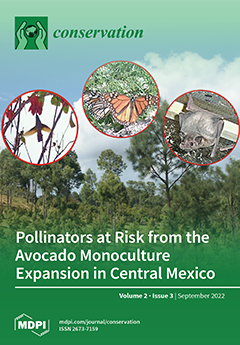Food safety is currently a serious concern due to the health risks associated with food intake, particularly due to heavy metal contamination. Therefore, the present study was conducted to investigate the heavy metals concentration in water and fishes collected from Hakaluki
haor,
[...] Read more.
Food safety is currently a serious concern due to the health risks associated with food intake, particularly due to heavy metal contamination. Therefore, the present study was conducted to investigate the heavy metals concentration in water and fishes collected from Hakaluki
haor, Bangladesh. Three important fish species,
Labeo rohita, Cirrhinus cirrhosis, and
Labeo calbasu, together with water samples, were analyzed for heavy metals (Pb, Cr, and Cd), respectively. Considering four seasons, namely the monsoon, post-monsoon, winter, and pre-monsoon, a total of 72 fish samples were collected from three fishing stations from June 2017 to May 2018. The results showed that the total mean concentration of metals in water (mg L
−1) was found to be in the order of Pb (0.125 ± 0.058) > Cr (0.026 ± 0.012) > Cd (0.001 ± 0.0002) within the maximum permissible limits set by the EU and WHO, except for Pb concentrations. Similarly, the total mean concentrations of Pb in fish (µg g
−1) were found in order of
L. rohita (0.388 ± 0.291) >
Cirrhinus cirrhosus (0.334 ± 0.236) >
L. calbasu (0.251 ± 0.117) greater than the maximum permissible limits (0.3 µg g
−1) set by FIQC, except for
L. calbasu. However, the mean concentrations of Cr and Cd in fish were found to be below the maximum permissible limits of FAO and FIQC, respectively. The quantity of heavy metal contamination in this
haor indicates that the situation is worrying for the region’s biota and residents. However, to protect public health and reduce environmental risk, the appropriate authorities should oversee and monitor it with strong hands.
Full article




